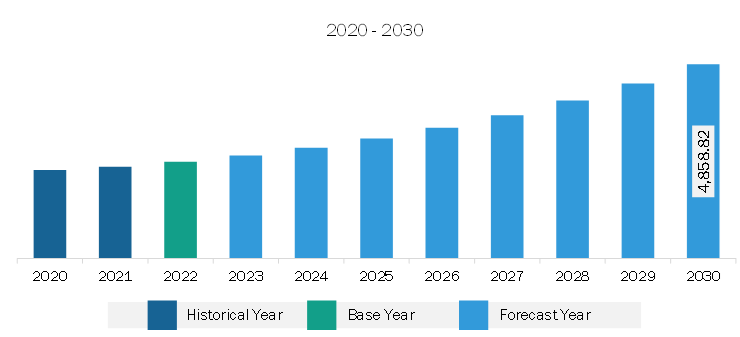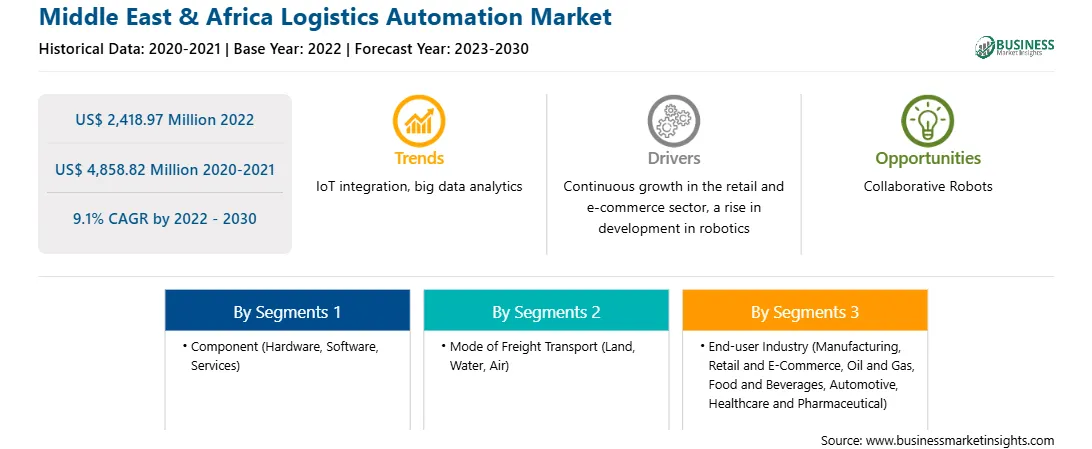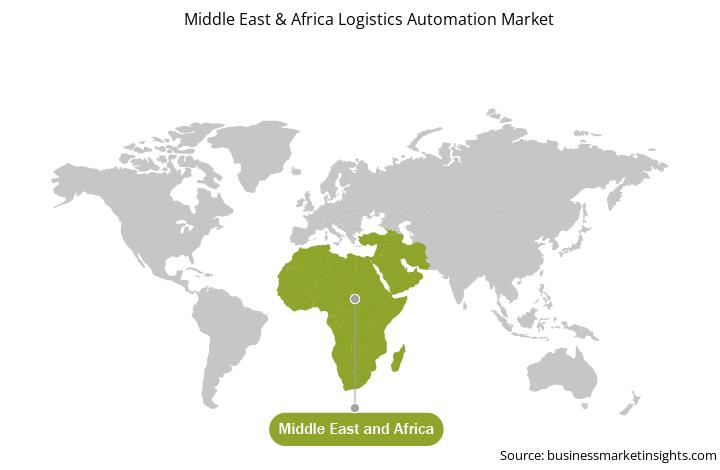The Middle East & Africa logistics automation market was valued at US$ 2,418.97 million in 2022 and is expected to reach US$ 4,858.82 million by 2030; it is estimated to register at a CAGR of 9.1% from 2022 to 2030. Continuous Growth in Retail & E-commerce Sector Bolsters Middle East & Africa Logistics Automation Market
Logistic automation is one of the substantial components of e-commerce for managing the issues of inventory, tracking, packing, warehousing, and shipping. In retail and e-commerce, the business is liable for safeguarding timely delivery and return policy. If the goods or products need to be replaced, the company must handle all the operations in reverse logistics. In the retail and e-commerce business, a logistics automation provider delivers upgraded technology, scalability and flexibility, and efficiency. Additionally, the e-commerce sector is growing.
The logistics requirements and services provided by the logistic automation software firms to retail and e-commerce businesses include warehouse management, supply chain management, consolidated services, and order fulfillment. There are several benefits related to e-commerce that can be fulfilled if the company outsources its logistics requirements through a logistic automation service provider. This allows the retail and e-commerce participants to perform their specific roles; accordingly, it is a reliable substitute for using the third-party organization in the retail & e-commerce ecosystem. Logistics automation firms specialize in supply chain management, allowing online stores to accentuate marketing and other business operations. The logistics automation software allows warehouse managers to deal efficiently with various processes such as multiline item sorting, split case picking, and palletizing. Therefore, logistics automation software has an enormous opportunity in the retail & e-commerce sector globally. This can propel the growth of the growth of the Middle East & Africa logistics automation market.Middle East & Africa Logistics Automation Market Overview
The Middle East & Africa logistics automation market consists of Saudi Arabia, the UAE, South Africa, and the Rest of Middle East & Africa. These countries are adopting factory automation and smart working techniques to enhance their manufacturing capabilities. For instance, Saudi Arabia is automating 4,000 factories to curb reliance on low-skilled workers. Also, to transform the country's manufacturing sector, the Ministry of Industry and Mineral Resources launched The Future Factories Program to build a robust tech ecosystem. Similarly, the UAE is focusing on the Fourth Industrial Revolution (4IR) or Industry 4.0 to increase productivity and provide more innovative products using automated systems. Through all the above initiatives, the Middle East & Africa is advancing toward automation, thus leading to the lucrative growth opportunity of the logistics automation market.
Middle East & Africa Logistics Automation Market Revenue and Forecast to 2030 (US$ Million)
Strategic insights for the Middle East & Africa Logistics Automation provides data-driven analysis of the industry landscape, including current trends, key players, and regional nuances. These insights offer actionable recommendations, enabling readers to differentiate themselves from competitors by identifying untapped segments or developing unique value propositions. Leveraging data analytics, these insights help industry players anticipate the market shifts, whether investors, manufacturers, or other stakeholders. A future-oriented perspective is essential, helping stakeholders anticipate market shifts and position themselves for long-term success in this dynamic region. Ultimately, effective strategic insights empower readers to make informed decisions that drive profitability and achieve their business objectives within the market. The geographic scope of the Middle East & Africa Logistics Automation refers to the specific areas in which a business operates and competes. Understanding local distinctions, such as diverse consumer preferences (e.g., demand for specific plug types or battery backup durations), varying economic conditions, and regulatory environments, is crucial for tailoring strategies to specific markets. Businesses can expand their reach by identifying underserved areas or adapting their offerings to meet local demands. A clear market focus allows for more effective resource allocation, targeted marketing campaigns, and better positioning against local competitors, ultimately driving growth in those targeted areas.
Middle East & Africa Logistics Automation Strategic Insights

Middle East & Africa Logistics Automation Report Scope
Report Attribute
Details
Market size in 2022
US$ 2,418.97 Million
Market Size by 2030
US$ 4,858.82 Million
Global CAGR (2022 - 2030)
9.1%
Historical Data
2020-2021
Forecast period
2023-2030
Segments Covered
By Component
By Mode of Freight Transport
By End-user Industry
Regions and Countries Covered
Middle East and Africa
Market leaders and key company profiles
Middle East & Africa Logistics Automation Regional Insights

Middle East & Africa Logistics Automation Market Segmentation
The Middle East & Africa logistics automation market is segmented based on component, mode of freight transport, application, end-user industry, and country.
Based on component, the Middle East & Africa logistics automation market is segmented into hardware, software, and services. The hardware held the largest share in 2022.
In terms of mode of freight transport, the Middle East & Africa logistics automation market is segmented into land, water, and air. The land segment held the largest share in 2022.
By application, the Middle East & Africa logistics automation market is bifurcated into warehouse management and transportation management. The warehouse management segment held a larger share in 2022.
In terms of end-user industry, the Middle East & Africa logistics automation market is segmented into manufacturing, retail and e-commerce, oil and gas, food and beverages, automotive, healthcare and pharmaceutical, and others. The manufacturing segment held the largest share in 2022.
Based on country, the Middle East & Africa logistics automation market is categorized into South Africa, Saudi Arabia, the UAE, and the Rest of Middle East & Africa. Saudi Arabia dominated the Middle East & Africa logistics automation market in 2022.
BEUMER Group GmbH & co KG, Dematic Corp, Honeywell Intonational Inc, KNAPP AG, Swisslog Holding AG, and TGW Logistics Group GmbH are some of the leading companies operating in the Middle East & Africa logistics automation market.
1. BEUMER Group GmbH & co KG
2. Dematic Corp
3. Honeywell Intonational Inc
4. KNAPP AG
5. Swisslog Holding AG
6. TGW Logistics Group GmbH
The Middle East & Africa Logistics Automation Market is valued at US$ 2,418.97 Million in 2022, it is projected to reach US$ 4,858.82 Million by 2030.
As per our report Middle East & Africa Logistics Automation Market, the market size is valued at US$ 2,418.97 Million in 2022, projecting it to reach US$ 4,858.82 Million by 2030. This translates to a CAGR of approximately 9.1% during the forecast period.
The Middle East & Africa Logistics Automation Market report typically cover these key segments-
The historic period, base year, and forecast period can vary slightly depending on the specific market research report. However, for the Middle East & Africa Logistics Automation Market report:
The Middle East & Africa Logistics Automation Market is populated by several key players, each contributing to its growth and innovation. Some of the major players include:
The Middle East & Africa Logistics Automation Market report is valuable for diverse stakeholders, including:
Essentially, anyone involved in or considering involvement in the Middle East & Africa Logistics Automation Market value chain can benefit from the information contained in a comprehensive market report.